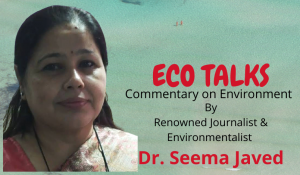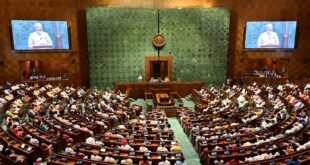 “Air pollution is the fourth leading cause of mortality and contributes to 12% of global deaths after tobacco and dietary factors, but in South Asia air pollution is the highest risk to public health compared to global factors.” This was stated by Health Effects Institute’s President, Dr Daniel Greenbaum at a webinar today titled “Opportunities for Addressing Air Pollution in South Asia”. The session was organised by Delhi based climate communications initiative, Climate Trends, and regional intergovernmental knowledge centre, ICIMOD, to understand the challenge that air pollution poses for the developing economies of South Asia.
“Air pollution is the fourth leading cause of mortality and contributes to 12% of global deaths after tobacco and dietary factors, but in South Asia air pollution is the highest risk to public health compared to global factors.” This was stated by Health Effects Institute’s President, Dr Daniel Greenbaum at a webinar today titled “Opportunities for Addressing Air Pollution in South Asia”. The session was organised by Delhi based climate communications initiative, Climate Trends, and regional intergovernmental knowledge centre, ICIMOD, to understand the challenge that air pollution poses for the developing economies of South Asia.
At 1.85 billion, South Asia is the world’s most populated region, comprising middle and lower-middle income countries which are afflicted with similar polluting sources and share a regional airshed making multi-sectoral mitigation efforts a mammoth challenge. However, experts agreed that if the problems of the region are similar and shared, so can the solutions be. Glynda Bathan, Deputy Executive Director, Clean Air Asia said, “In-country air pollution sources are a priority for countries to control, reduce and manage. Examples from other parts of the world show that for sources that are outside the national boundaries, countries have little or no control over. Addressing transboundary pollutants requires regional cooperation, which needs a strong foundation of political will and science.”
Providing a domestic example, Prof S N Tripathi, Head of Civil Engineering Department at Indian Institute of Technology Kanpur said, “While Kathmandu and the entire Gangetic plains have a valley effect, making the odds against them, cities in South Asia are not only impacted by their topography and meteorological factors. A comparative analysis between Kanpur, which is a representative site of the Indo-Gangetic Plains, and Dhaka shows that even if PM2.5 levels in Dhaka are lesser in comparison to Kanpur, the lead (Pb) concentration is far higher and exceeds even the NOx values for a good part of the year in Dhaka. Lead is a carcinogen generated from solid fuels used in household cooking, while nitrogen dioxide emissions are mostly attributed to transport.”

Clearly, domestic policies like India’s Pradhan Mantri Ujjawala Yojana, which was lauded by some of the experts, has provided a successful solution in the form of 14 crore LPG connections in India, making a huge difference. Household cooking contributes to one-fourth of the mortality burden due to air pollution in the region. Prof Tripathi further added, “An early estimate from the Central Pollution Control Board and IIT Delhi shows that there’s a 20% reduction in PM2.5 levels in Delhi in the last 4 years due to policy measures taken in the National Capital Region, like switching to cleaner BSVI fuel, installing CEMS monitoring across all industries, cleaner zigzag technology in brick kilns, eastern and western peripheral highways which bypass heavy traffic from city limits, and happy seeders which addressed the crop residue burning to an extent.”
Meanwhile air pollution is considered an invisible environmental problem in neighboring Bangladesh where deforestation rate is double that of the global average, Dhaka experiences a methane cover due to open landfills and the World Bank counts brick manufacturing as a leading source of pollution in the country.
Supreme Court lawyer and Chief Executive of Bangladesh Environmental Lawyers Association, Syeda Rizwana Hasan said, “Even though Dhaka ranks as the second most polluted city in the world, often beating levels even in Delhi, the Government of Bangladesh still perceives it as an invisible problem. Instead of creating a specific parent law to tackle pollution holistically in the country, they created a bylaw under the Environment Conservation Act.
Which means that instead of setting up a new institutional framework, they shouldered the entire responsibility on the already overburdened Department of Environment.”
However, it is becoming increasingly clear that a parent law also needs a more comprehensive strategy when addressing a breadth of issues vis-a-vis air pollution.
India’s National Clean Air Programme (NCAP) was set up in response to the acutely polluted Indian cities and aims to reduce upto 30% PM2.5 and 10 levels in 122 non-attainment cities which do not meet the national air quality standards. However, Prof Tripathi claims that it is apparent that a bottoms-up city level approach needs to be coupled with a regional airshed strategy for an effective air pollution management effort, “We at the National Knowledge Network, which has been set up to provide scientific guidance to achieve India’s NCAP goals, have been entrusted with the responsibility to start thinking of an airshed approach, first as provincial management, then expanding into states and then into regions beyond state borders that fall under the same airshed.
This airshed approach will be helpful for other South Asian countries as well.”

Air pollution is an anthropogenic (human-influenced) impact on the environment and increasingly research is showing that its impacts are not limited to human health but also affecting the fine balance of weather systems. “The nature of pollutants in the Himalayan region are increasingly changing their behaviour. They are more effective in absorbing sunlight,” explains Dr Maheswar Rupakheti, Research Group Leader at IASS in Potsdam, Germany. He believes that to truly address pollution holistically, we need to have a “dragonfly’s eye view with multiple lenses”.
“The common understanding of working together in a multidisciplinary, transdisciplinary, interdisciplinary manner is still largely missing in South Asia. We need to have a common understanding of the processes first, then we need a common understanding of the sustainability challenge, and then we work together to define the solutions which are then more likely to be effective and will lead to transformation. ”
Any incremental change will require scientific understanding of the problem and data sits at the heart of this research requirement. Data is a glaring gap for South Asian countries — whether it is air quality monitoring data where expensive regulatory grade monitoring networks are not dense enough or the lack of mortality and disease burden data due to air pollution. Granular information on specific health impacts is harder to find as most countries in the region still do not have the systems in place which recognise air pollution as a risk factor for health and register it as cause for mortality. In the absence of reliable national level monitoring and health data, research is limited to
smaller studies and surveys.
Syeda Rizwana Hasan said, “Monitoring is mandatory and especially for the most polluted parts of the country, but along with the quantity of monitoring stations, the quality of data should also be maintained. Providing statistics only when it is raining heavily will not solve the problem.” Increasing monitoring is a budgetary challenge as well for South Asian countries, however, low-cost sensor based technology is receiving widespread acknowledgement as a cost-effective solution. Glynda Bathan said, “Hybrid monitoring is a viable option where a few reference grade monitors can be augmented with a wide network of micro air sensors. These provide cities an opportunity to access hyperlocal real-time data and decisions can be taken quickly at city levels to address specific sources.”
The parallels between these countries offer solutions to collectively work on the problem by pooling resources like knowledge sharing, indigenous low-cost technology and lessons from global case studies which can bring down barriers to understanding about economic co-benefits and bridge the gaps between sustainability and development. Examples from across the world where countries have successfully reduced their air pollution levels are evidence that pollution mitigation is not a compromise on economic development, in fact it can provide economic co-benefits for industries in clean technology and reduce the cost of healthcare.
Dr James J Schauer, Professor, Civil and Environmental Engineering at University of Wisconsin said, “I have often heard the industry complain that transition to clean technologies is expensive. 30 years ago I helped build clean oil refineries in Nigeria and the Philippines, so if it could be done in these countries then, it can definitely be done in any part of the world now. This transition has a lot of co- benefits and promoting that understanding is crucial. There is tremendous assessment about how the US economy was able to grow during the time it tried to clean its air, leading to incredible entrepreneurial opportunities. We need to ensure that this transition is aligned, so the focus on long term climate benefits does not delay the improvement in air quality now.”
The Hindu Kush Himalayan region supports one-third of the global population and is at the receiving end of climate change impacts. Dr Pema Gyamtsho, Director General, ICIMOD concluded, “Although the Hindu Kush Himalayan region is considered the pulse of the planet, the South Asian region is a pollution hotspot with black carbon deposits increasing on the mountains. There is opportunity to address the problem together through research, coordination, cooperation and innovation from stakeholders in the region. This is a transboundary issue and its impacts will be felt by the region as a whole.”
 Jubilee Post News & Views
Jubilee Post News & Views





